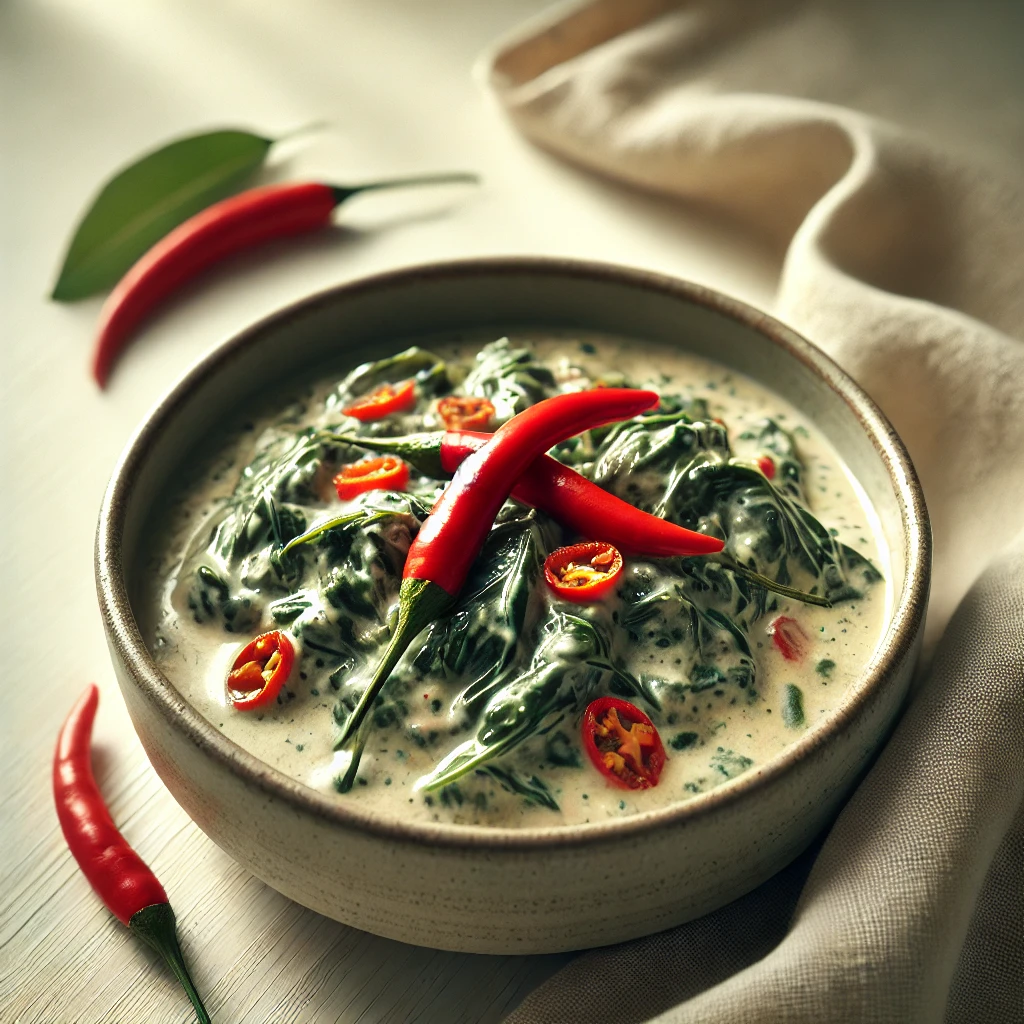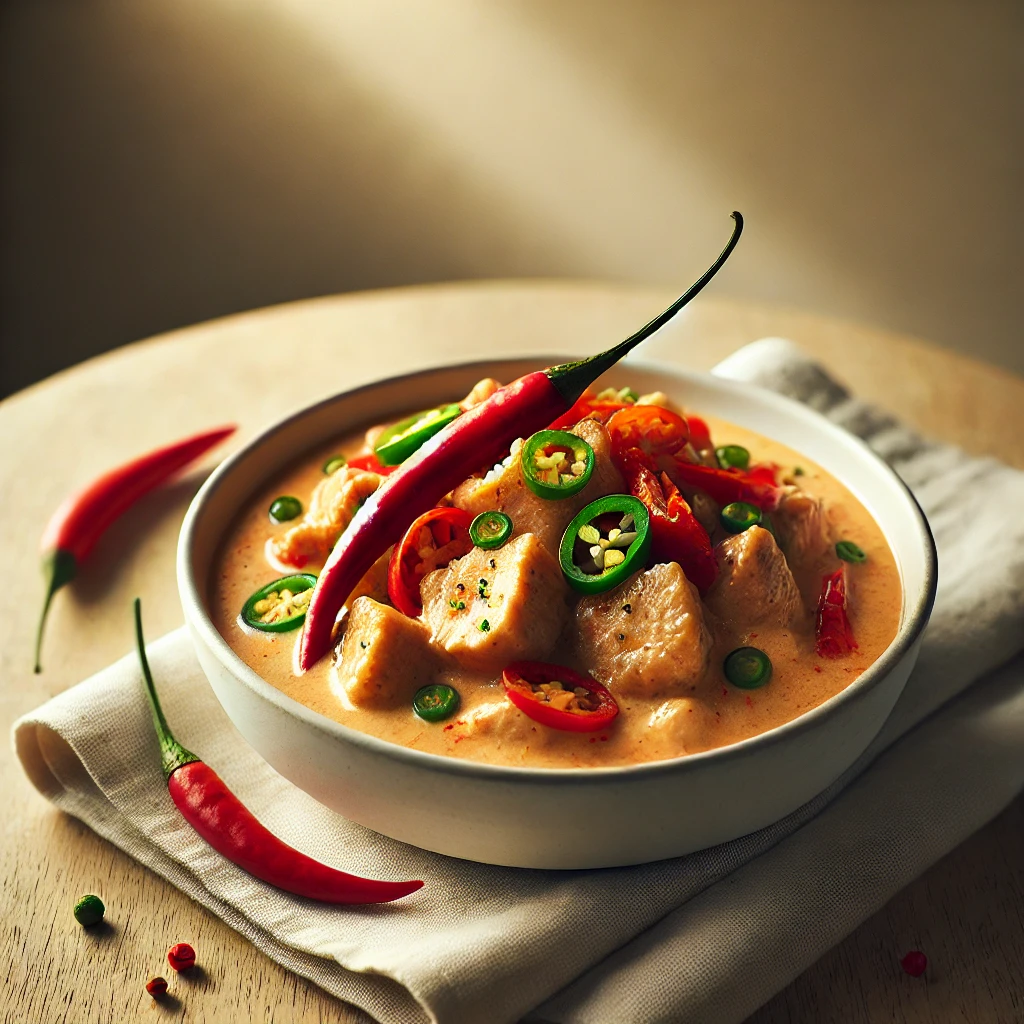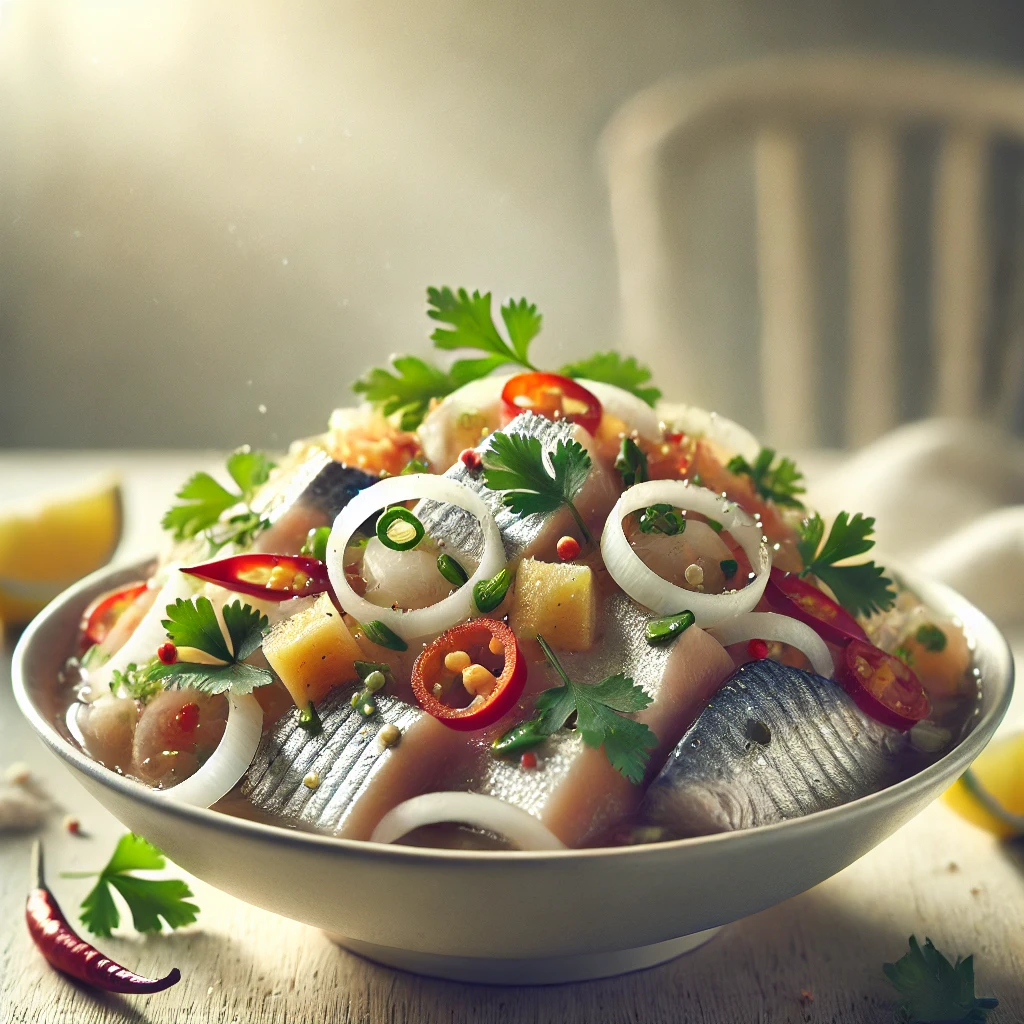Have you ever tasted a dish that simultaneously comforts your soul and sets your taste buds on fire? If not, prepare to embark on a culinary journey with Laing, a mouthwatering delicacy hailing from the Bicol region of the Philippines. This unique dish combines the earthy flavors of taro leaves with the richness of coconut milk and the fiery kick of chili peppers, creating a harmonious blend that will leave you craving more.
Laing isn’t just a dish; it’s a representation of Bicolano culture and cuisine. The people of Bicol are known for their love of spicy food, and Laing perfectly encapsulates this passion. But don’t let the heat scare you away – the creamy coconut milk balances the spiciness, making it accessible to even those with milder palates.
What sets Laing apart is its use of taro leaves, known locally as “gabi” leaves. These large, heart-shaped leaves are dried before cooking, concentrating their flavor and giving the dish its distinct texture. Combined with tender pork, aromatic garlic and ginger, and a generous amount of coconut milk, Laing transforms into a luxurious, hearty stew that’s perfect for any occasion.
For those with dietary restrictions, Laing can be easily adapted. Omit the pork for a vegetarian version, or use vegetable oil instead of pork fat for a completely vegan dish. The coconut milk makes it naturally dairy-free, and with no flour or grains involved, it’s also gluten-free. This versatility makes Laing an excellent choice for gatherings where you need to cater to various dietary needs without compromising on flavor.
Now, let’s dive into the heart of this Bicolano treasure and learn how to bring a taste of the Philippines to your own kitchen.
Recipe Ingredients
To make Laing for 4-6 servings, you’ll need the following ingredients:
| Ingredient | Quantity |
|---|---|
| Dried taro leaves | 2 cups, tightly packed |
| Pork belly | 1/2 pound, diced |
| Coconut milk | 2 cups |
| Coconut cream | 1 cup |
| Garlic | 6 cloves, minced |
| Ginger | 2-inch piece, minced |
| Shrimp paste (bagoong) | 2 tablespoons |
| Red Thai chili peppers | 5-7, finely chopped |
| Onion | 1 medium, diced |
| Salt | To taste |
| Pepper | To taste |
| Water | 1 cup |
Substitution suggestions:
- For a vegetarian version, replace pork belly with firm tofu or mushrooms.
- If you can’t find shrimp paste, use fish sauce as an alternative.
- Adjust the number of chili peppers based on your heat preference.
- Fresh taro leaves can be used if available, but increase the quantity to 4 cups and reduce cooking time.
Recipe Instructions
Follow these steps to create your own delicious Laing:
- Prepare the taro leaves:
- If using dried taro leaves, soak them in water for about 30 minutes, then drain and chop roughly.
- If using fresh leaves, wash thoroughly and chop into bite-sized pieces.
- Cook the pork:
- In a large pot or wok, cook the diced pork belly over medium heat until it renders its fat and becomes crispy. Remove the pork and set aside, leaving the fat in the pot.
- Sauté the aromatics:
- In the same pot with the pork fat, sauté the minced garlic, ginger, and diced onion until fragrant and translucent.
- Add the shrimp paste:
- Stir in the shrimp paste and cook for another minute to release its flavors.
- Incorporate the taro leaves:
- Add the chopped taro leaves to the pot and stir to combine with the aromatics.
- Pour in the liquids:
- Add the coconut milk, water, and half of the coconut cream. Stir well to combine.
- Simmer the dish:
- Bring the mixture to a boil, then reduce heat and simmer for about 30-40 minutes, stirring occasionally. The liquid should reduce and the leaves should become tender.
- Season and add heat:
- Add salt and pepper to taste.
- Stir in the chopped chili peppers, adjusting the amount to your desired level of spiciness.
- Reintroduce the pork:
- Add the cooked pork back into the pot and simmer for another 10 minutes to allow the flavors to meld.
- Finish with coconut cream:
- Pour in the remaining coconut cream and stir gently. Simmer for an additional 5 minutes until the sauce thickens slightly.
- Serve:
- Remove from heat and let it rest for a few minutes before serving.
- Laing is traditionally served with steamed rice.
Recipe Tips & Variations
To ensure your Laing turns out perfect every time, keep these tips in mind:
- Taro leaf handling: When working with fresh taro leaves, wear gloves to avoid skin irritation from the calcium oxalate crystals present in raw leaves. Cooking neutralizes these crystals, making the leaves safe to eat.
- Achieving the right consistency: The final dish should have a thick, creamy consistency. If it’s too watery, simmer uncovered for a few more minutes. If it’s too dry, add a bit more coconut milk.
- Flavor variations: For a seafood twist, add some peeled shrimp or flaked smoked fish (tinapa) in the last 5 minutes of cooking.
- Vegetarian option: Replace the pork with cubed firm tofu or sliced mushrooms. Use vegetable oil for sautéing instead of pork fat.
- Storage: Laing tastes even better the next day as the flavors continue to develop. Store in an airtight container in the refrigerator for up to 3 days. Reheat gently on the stovetop, adding a splash of water or coconut milk if needed.
Nutritional Information
While exact nutritional values can vary based on specific ingredients and portions, here’s an approximate breakdown per serving (assuming 6 servings):
| Nutrient | Amount |
|---|---|
| Calories | 350 |
| Total Fat | 28g |
| Saturated Fat | 20g |
| Cholesterol | 25mg |
| Sodium | 450mg |
| Total Carbohydrates | 15g |
| Dietary Fiber | 5g |
| Protein | 12g |
Conclusion
Laing is more than just a dish; it’s a celebration of Bicolano culture and a testament to the rich culinary traditions of the Philippines. As you savor each spoonful of this creamy, spicy delight, you’re not just enjoying a meal – you’re experiencing a piece of Filipino history and ingenuity.
I remember the first time I tasted Laing during a visit to Bicol. The explosion of flavors, the perfect balance of heat and creaminess, and the unique texture of the taro leaves left an indelible mark on my palate. It was a dish that told a story – of volcanic soil that nurtured the taro plants, of coconut trees swaying in the tropical breeze, and of a people who love their food fiery and full of life.
Now it’s your turn to create this culinary masterpiece in your own kitchen. Don’t be intimidated by the unique ingredients or the cooking process – embrace the adventure! And remember, cooking is all about personal taste, so feel free to adjust the spiciness or try out different variations to make it your own.
Once you’ve made your Laing, why not share your creation with friends and family? It’s a fantastic way to introduce them to Filipino cuisine and spark conversations about food, culture, and tradition. And don’t forget to snap a photo of your dish – we’d love to see how it turned out!
If you enjoyed this recipe, there’s a whole world of Filipino cuisine waiting to be explored. From the tangy Sinigang to the festive Lechon, each dish has its own story to tell. So keep cooking, keep exploring, and keep sharing the joy of food with those around you.
Kain na tayo! (Let’s eat!)
Additional Elements
Related recipes and pairings:
- Pinangat: Another Bicolano dish similar to Laing but wrapped in gabi leaves and steamed.
- Bicol Express: A spicy pork stew also from the Bicol region.
- Garlic Fried Rice: A perfect accompaniment to balance the richness of Laing.
- Calamansi Juice: A refreshing citrus drink to cool your palate.
Serving suggestions:
Serve Laing hot over a bed of steamed white rice. For a complete meal, pair it with grilled fish or chicken. A side of fresh mango or pineapple can provide a sweet contrast to the spicy dish.
Equipment recommendations:
- Large wok or heavy-bottomed pot
- Sharp knife for chopping ingredients
- Wooden spoon or spatula for stirring
Historical and cultural context:
Laing originated in the Bicol region, located in the southeastern part of Luzon island in the Philippines. The area is known for its abundance of coconut trees and taro plants, which heavily influence the local cuisine. The dish’s spiciness is attributed to the region’s volcanic soil, which is ideal for growing chili peppers. Laing has been a staple in Bicolano households for generations and has gained popularity throughout the Philippines and beyond.
Disclaimer: This recipe blog post is based on information available up to 2019. While we strive for accuracy, culinary traditions and recipes may evolve over time. If you notice any inaccuracies or have updated information, please report them so we can correct them promptly.




